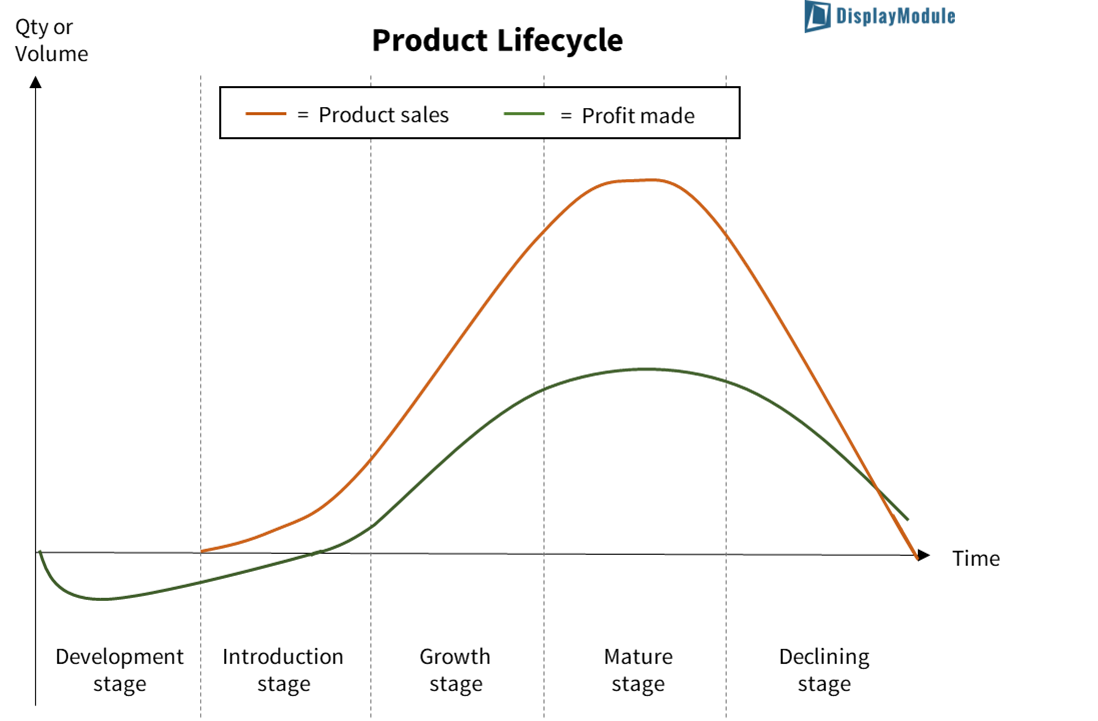The product lifecycle (PLC) describes the full journey of a product from its initial development and introduction to its eventual discontinuation from the market. The product lifecycle is made up of 5 stages: development, introduction, growth, maturity, and decline.

Let’s first dive into the different stages of the product lifecycle:
-
Development
The product development stage is the initial phase of the product lifecycle, where a new product idea is developed and refined into a finished product ready for launch.
During this development stage, companies usually haven’t generated profits yet, and hence they rely on their initial investments to complete their market research, design their products, and test prototypes.
Companies can also get additional investments (other than personal funding) through venture capital (VCs), angel investors, or take loans. They can also rely on partnerships to strategize the company’s finance.
-
Introduction
The introduction stage of the product lifecycle starts with the initial launch of the new product into the market.
During this stage, the company should react as fast as possible to the input and change in market demand. If you’re launching new technology, then good news! You’ll find yourself having very few to no competitions at this stage. Hence, you can maximize your profits through sales.
This being said, the cost of production will still be imposed. To stay ahead in the game, the company should continuously refine its marketing strategy to build brand awareness and generate demand among potential customers.
-
Growth
As the product grows in the market and becomes more well-known, the growth stage starts. The growth stage is characterized by rapid sales increase and increasing competition.
Companies NEED to differentiate their product from competitors. In addition, creating an agile marketing, sales, and management strategy should also be optimized during this stage.
-
Maturity
The maturity stage is reached when the product’s market has started to become saturated and the profit growth has slowed down. A product has also become mature when it has reached its peak sales and market share.
During this time, the company will focus on maximizing profits by optimizing its production and refining its marketing strategy to keep its product status. This could be done by providing product upgrades or shifting market segments.
-
Decline
The decline stage starts when product sales and market share start to decline. A product’s decline can occur due to too many competitors, market saturation, and changing market.
At this stage, the company focuses on minimizing losses, and develop a new product — moving along the product lifecycle again.
Consumer demand and technological advancements are key drivers of the product lifecycle, as they shape consumption patterns and influence product design and marketing strategies. Throughout the lifecycle, factors such as product features, market demand, consumer behavior, and market structure are continually evolving, which impacts the product's performance and success in the market.
Production management, such as the control of material procurement, storage, and utilization should also be optimized based on the product lifecycle.
Learn more about Material Optimization for Product Lifecycle: https://knowledgebase.nexpcb.com/articles/product-lifecycle/
Read more

PCB Connectors, or Printed Circuit Board connectors, are components that are used to connect printed circuit boards (PCBs) to other electronic parts, such as LEDs, sensors, displays, wires, and eve...

As different printed circuit boards (PCBs) each have their own specific use, their composition: layers, materials, components, mounting technology, and numerous other processes are different. One o...



Leave a comment
This site is protected by hCaptcha and the hCaptcha Privacy Policy and Terms of Service apply.